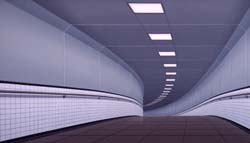

Studies for "Pedestrian Tunnel"
|
In the process of completing the 1991 painting Pedestrian Tunnel, Christopher Pratt made a number of different studies for a number of different purposes. He says: "I did a number of sketches based on experiences in airports and hospitals and tunnels underground. Then I started drawing curves intuitively, erasing and refining, trying to describe a vortex and a sense that the thing went on forever, never resolving, that there was nothing at the end of it, darkness nor light, that it could only return into itself. When I could feel the tunnel at my back, I used a tracing paper overlay to analyse the lines - I wanted the perspective to be logical. Then I enlarged the curves onto a canvas and drew in the lights and tiles and Jeanette got at the underpainting while I was finishing Black Pickup. I had done a colour study in which the tunnel looked hi-tech, as if it were extruded stainless steel, but that didn't work - it was too surrealistic to be disquieting. My nephew Matthew Ryan saw it and said, 'Hey, Darth Vader - wow': he is a young man with Down's Syndrome, blessed with gifts of observation, if not tact. I brought it 'back to earth' - I have been in hospitals, but not to outer space." If the
above quote from a book called Christopher Pratt: Personal Reflections
on a Life in Art illustrates anything, it is the necessity of the
study process to a finished work. Have a look at the following studies.
 Don't forget to have a look at the finished work, Pedestrian Tunnel. Notice how the changes made in study four are incorporated in the finished work. Now that we've looked at the study process, it's time to look at the individual processes behind the different media Pratt works in. You'll find that here. return to studies return to process/media |
